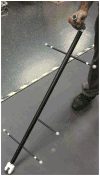Minimum toe clearance adaptations to floor surface irregularity and gait speed
- PMID: 21354576
- PMCID: PMC5375113
- DOI: 10.1016/j.jbiomech.2011.02.010
Minimum toe clearance adaptations to floor surface irregularity and gait speed
Abstract
Toe speed during gait generally nears its maximum while its height reaches a local minima approximately halfway through swing phase. Trips are thought to frequently occur at these local minima (minimum toe clearance or MTC events) and trip risk has been quantified using the minimum distance between the toe and ground here (MTC). This study investigated MTC on floor surfaces with and without multiple small obstacles. After shoes and floor surfaces were digitized, 14 unimpaired subjects (half women) each traversed a 4.88 m walkway 4 times at slow, preferred, and fast speeds across surfaces with no obstacles, visible obstacles, and hidden obstacles. Both surfaces with obstacles had the same random obstacle configuration. Shoe and body segment motions were tracked using passive markers and MTC and joint kinematics calculated. All MTC and kinematic variables tested significantly increased with faster instructed gait speed except the likelihood of MTC event occurrence (local minima in minimum toe clearance trajectory when foot is in upper quartile of speed). MTC events were less frequent for swing phases on surfaces with obstacles (80% vs. 98% for no obstacles). MTC values, when present, were doubled by the presence of visible obstacles (22.2 ± 7.3mm vs. 11.1 ± 5.7 mm) and further increased to 26.8 ± 7.1mm when these obstacles were hidden from view (all comparisons p ≤ 0.0003). These substantial floor surface-related changes in MTC event occurrences and values resulted from alterations in toe- and heel-clearance trajectories caused by subtle but significant changes in joint kinematics that did not exceed 10% each joint's swing phase range of motion.
Published by Elsevier Ltd.
Conflict of interest statement
The author has no relationship with any organization or person that may bias this work.
Figures








Similar articles
-
A new measure of trip risk integrating minimum foot clearance and dynamic stability across the swing phase of gait.J Biomech. 2017 Apr 11;55:107-112. doi: 10.1016/j.jbiomech.2017.02.024. Epub 2017 Feb 27. J Biomech. 2017. PMID: 28302314 Free PMC article.
-
Minimum toe clearance events in divided attention treadmill walking in older and young adults: a cross-sectional study.J Neuroeng Rehabil. 2015 Jul 12;12:58. doi: 10.1186/s12984-015-0052-2. J Neuroeng Rehabil. 2015. PMID: 26162824 Free PMC article.
-
Non-MTC gait cycles: An adaptive toe trajectory control strategy in older adults.Gait Posture. 2017 Mar;53:73-79. doi: 10.1016/j.gaitpost.2016.11.044. Epub 2016 Nov 29. Gait Posture. 2017. PMID: 28113075
-
Alternative measures of toe trajectory more accurately predict the probability of tripping than minimum toe clearance.J Biomech. 2016 Dec 8;49(16):4016-4021. doi: 10.1016/j.jbiomech.2016.10.045. Epub 2016 Nov 1. J Biomech. 2016. PMID: 27825600
-
Contributions to the understanding of gait control.Dan Med J. 2014 Apr;61(4):B4823. Dan Med J. 2014. PMID: 24814597 Review.
Cited by
-
Healthy younger and older adults control foot placement to avoid small obstacles during gait primarily by modulating step width.J Neuroeng Rehabil. 2012 Oct 3;9:69. doi: 10.1186/1743-0003-9-69. J Neuroeng Rehabil. 2012. PMID: 23034093 Free PMC article.
-
Modelling of the toe trajectory during normal gait using circle-fit approximation.Med Biol Eng Comput. 2016 Oct;54(10):1481-9. doi: 10.1007/s11517-015-1414-4. Epub 2015 Nov 20. Med Biol Eng Comput. 2016. PMID: 26589319
-
Application of vibration to the soles reduces minimum toe clearance variability during walking.PLoS One. 2022 Jan 4;17(1):e0261732. doi: 10.1371/journal.pone.0261732. eCollection 2022. PLoS One. 2022. PMID: 34982783 Free PMC article. Clinical Trial.
-
Does Gait with an Ankle Foot Orthosis Improve or Compromise Minimum Foot Clearance?Sensors (Basel). 2021 Dec 3;21(23):8089. doi: 10.3390/s21238089. Sensors (Basel). 2021. PMID: 34884093 Free PMC article.
-
Gait characteristics of individuals with transtibial amputations walking on a destabilizing rock surface.Gait Posture. 2012 May;36(1):33-9. doi: 10.1016/j.gaitpost.2011.12.019. Epub 2012 Apr 1. Gait Posture. 2012. PMID: 22469772 Free PMC article.
References
-
- CDC. [Accessed July 30, 2010];WISQARS (Web-based Injury Statistics Query and Reporting System) Available at: http://www.cdc.gov/injury/wisqars/index.html. - PubMed
-
- National Center for Injury Prevention and Control. [Accessed July 30, 2010]; Available at: http://www.cdc.gov/ncipc/wisqars/nonfatal/quickpicks/quickpicks_2007/all....
-
- Begg R, Best R, Dell’Oro L, Taylor S. Minimum foot clearance during walking: strategies for the minimisation of trip-related falls. Gait & Posture. 2007;25(2):191–198. - PubMed
-
- Bejek Z, Paróczai R, Illyés A, Kiss RM. The influence of walking speed on gait parameters in healthy people and in patients with osteoarthritis. Knee Surgery, Sports Traumatology, Arthroscopy: Official Journal of the ESSKA. 2006;14(7):612–622. - PubMed
-
- Blake AJ, Morgan K, Bendall MJ, Dallosso H, Ebrahim SB, Arie TH, Fentem PH, Bassey EJ. Falls by elderly people at home: prevalence and associated factors. Age and Ageing. 1988;17(6):365–372. - PubMed
Publication types
MeSH terms
Grants and funding
LinkOut - more resources
Full Text Sources

